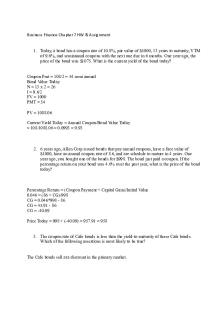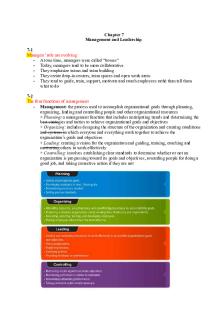Chapter 7 Business Ownership PDF

| Title | Chapter 7 Business Ownership |
|---|---|
| Author | Matthew Ward |
| Course | Introduction to Business and Management |
| Institution | University of Maryland Global Campus |
| Pages | 5 |
| File Size | 155.2 KB |
| File Type | |
| Total Downloads | 81 |
| Total Views | 145 |
Summary
Chapter 7 Business Ownership Professor Ryan Lessans...
Description
o o o o o o o o
The following are some of the important factors business owners should consider when selecting a form of ownership Cost of Start-up Control vs Responsibility How much profits you want to share Taxation Entrepreneurial Ability Risk Tolerance Financing Continuity and Transferability Business Types
o Sole Proprietorships No distinction between the business and the owner fictitious name (also known as an assumed name, trade name, or DBA name—short for “doing business as”). This document is usually filed in the records of the county or city in which you do business. This requirement exists because if customers want to contact (or sue) the person running the business, the law requires the owner to inform the public of the person behind the “business.” Easy and inexpensive to form Complete control Easy tax preparation. Lowest tax rates of the business structures. Owner and business are taxed as one Unlimited personal liability Hard to raise money Heavy burden o Partnerships Two general types General partnerships – all aspects are divided equally unless documented in the partnership agreement Limited partnerships – can allow for limited liability and input. Attractive to short term projects Must register business and obtain licenses and permits. This varies by location but is generally handled through the Secretary of State’s office Business does not pay taxes, partners pay taxes based off divided profits. May also have to pay income, self-employment, and estimated tax. Easy and inexpensive to create. Most time/money spent on developing the partnership agreement Shared financial commitment Complementary skills between partners should be considered
Joint and Individual liability, liable for own actions and partners actions. Can be forced to use personal assets to pay debts Disagreement between partners can occur Profits are shared o Corporation They have unique status and rights in America. This includes Corporate Personhood, this means the corporation has some, but not all of the legal rights and responsibilities enjoy be humans. Corporation Types C Corporation o Owned by shareholders o The corporation is legally liable for actions and debts, not the shareholders o Called C because it falls under Subchapter C of Chapter 1 of the Internal Revenue Code o Corporation must be formed and recognized by the Secretary of State office. This includes filing articles of incorporation, possibly establishing directors and issuing stock certificates. o Creates a Separate Tax-paying Entity. Corporations pay taxes on their profits. Those profits are then taxed again when they are paid to shareholders. This double tax only applies to the dividends from profits, not money paid as salary. o Limited liability – shareholders personal assets are protected and only accountable for their investment stock o Ability to generate capital through selling stocks o Corporate Tax Treatment can result in lower income tax rate o Attractive to potential employees due to competitive benefits and potential for ownership through stocks o Cost heavy time and money to start and operate. o Additional paperwork required due to government regulations S Corporation o Created from Subchapter S o Must charter a business as a corporation in its home state. Liability can be passed to your personal tax return. S Corp is not taxed, but the shareholders are. o All shareholders must elect the corporation to become an S Corp o Some states treat and S Corp the same as the federal government for tax purposes, some treat them like C Corps, and others have their own rules. o Tax Savings is one of the best features o Business Expense Tax Credits are credits that can be written off by shareholders for business expenses. o Allows corporation to have an Independent Life separate from shareholders.
o Stricter Operational Processes, such as requirement to have scheduled director, shareholder meetings, publishes minutes from the meetings, adoption and updates to by-laws, stock transfers, and records maintenance o Shareholder Compensation Requirements, shareholders must receive reasonable compensation B Corp o For-profit, authorized by 30 states, includes positive impact on society, workers, the community, and the environments in its legally defined goals o General creation process is Declare a commitment to creating general public benefit Adopt a third-party standard Prepare an annual benefit report Distribute the report to owners and to company website o Protection of mission provides more options and protections if the decide to sell or take business public o Reputation, this stands out as having a social conscience o Creation of Value via employee engagement and customer loyalty o Transparency and reporting requirements are cumbersome o Annual fees to retain statue are based on annual sales and must pay renewal each year and recertify every two years o Compliance and Governance Obligations, requires a benefit directors that ensures it meets its stated purpose Hybrid forms of ownership Limited Liability Company (LLC) o Provide liability features of a corporation with tax features of a partnership o Owners are called members o Creation Choose a business name (Must be unique, must say LLC, and cannot use restricted words such as bank or insurance) File the Articles of Organization Create an Operating Agreement Obtain Licenses and Permits Announce the business if required o All taxes are passed onto the members o Limited Liability, members are protected o Less Record Keeping o Sharing of Profits is left up to member discretion o Can have limited life o Members encur self-employment taxes Limited Liability Partnership (LLP)
o o o o o o o o
Some partners have limited liabilities Forming Verify eligibility status Choose a name Draft a Limited Liability Partnership Agreement File a Certificate of Limited Liability Partnership Obtain licenses and permits Announce the Business Same tax structure as LLC Single Taxation Limited Liability Flexibility Duration can be limited Limitation of formation may not be recognized in every state
o Partner Control can be a problem without a partnership agreement
Franchises o Involves one business owner licensing trademarks and methods to an independent entrepreneur for a prescribed period of time o Generally required to be establishes as a corporation or LLC and taxed in that manner o Access to capital for growth and expansion o Cash flow for operations, initial franchise fees between 50,000 to 5 mil, royalties between 4-8 percent of gross revenues o Economies of Sale, can centralize purchasing and distribution locations to lower cost o Lack of control over the franchisee o Trade secrets may be copied o Overexposure or brand dilution can occur o Franchisee has less risk than starting from scratch, o Receives brand recognition o Has access to ongoing support o Has relative autonomy o Franchisee must pay additional cost in franchise fees o Unequal partnership as franchisor sets the rules o Rules and enforcement, some franchisors may use a minor violation to terminate the contract or seize the franchise
When businesses acquire other businesses or operations that were previously competitors, suppliers, buyers, or sellers, they are engaging in a strategy known as integration.
o A merger is the consolidation of two companies, this usually creates one larger company and the originals cease to exist A horizontal merger occurs between companies in the same industry. Basically a consolidation. A vertical merger is the merger of two organizations that have a buyer-seller relationship. o An Acquisition is when a company purchases another company...
Similar Free PDFs

Chapter 7 Business Ownership
- 5 Pages

Co-Ownership week 7
- 12 Pages

Chapter 7 Business Marketing
- 34 Pages

Extreme Ownership Chapter 1
- 1 Pages

Class Chapter 5- Ownership
- 11 Pages

Business Finance Chapter 7-9
- 12 Pages
Popular Institutions
- Tinajero National High School - Annex
- Politeknik Caltex Riau
- Yokohama City University
- SGT University
- University of Al-Qadisiyah
- Divine Word College of Vigan
- Techniek College Rotterdam
- Universidade de Santiago
- Universiti Teknologi MARA Cawangan Johor Kampus Pasir Gudang
- Poltekkes Kemenkes Yogyakarta
- Baguio City National High School
- Colegio san marcos
- preparatoria uno
- Centro de Bachillerato Tecnológico Industrial y de Servicios No. 107
- Dalian Maritime University
- Quang Trung Secondary School
- Colegio Tecnológico en Informática
- Corporación Regional de Educación Superior
- Grupo CEDVA
- Dar Al Uloom University
- Centro de Estudios Preuniversitarios de la Universidad Nacional de Ingeniería
- 上智大学
- Aakash International School, Nuna Majara
- San Felipe Neri Catholic School
- Kang Chiao International School - New Taipei City
- Misamis Occidental National High School
- Institución Educativa Escuela Normal Juan Ladrilleros
- Kolehiyo ng Pantukan
- Batanes State College
- Instituto Continental
- Sekolah Menengah Kejuruan Kesehatan Kaltara (Tarakan)
- Colegio de La Inmaculada Concepcion - Cebu









